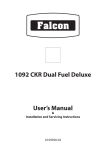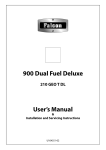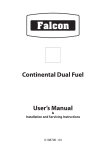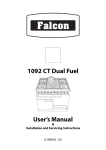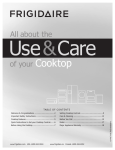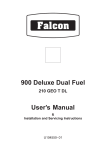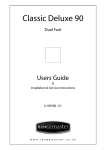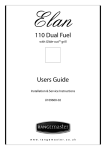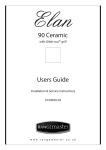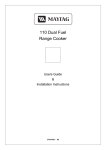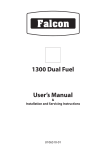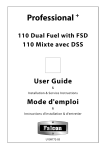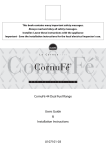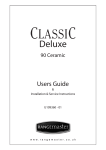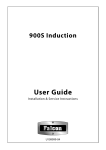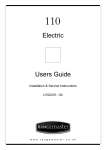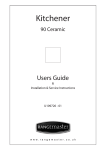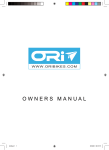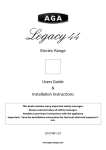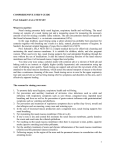Download U103701-02 Falcon 1092 DF Deluxe (Oct
Transcript
1092 Dual Fuel Deluxe 211 GEO T DL User’s Manual & Installation and Servicing Instructions U103701-02 Be safe Warning Accessible parts will become hot in use. To avoid burns and scalds children should be kept away. You need clean fresh air - so does your cooker. Burner flames produce exhaust gases, heat and moisture. Make sure that the kitchen is well ventilated: keep natural ventilation holes open or install a powered cooker hood that vents outside. If you have several burners on or use the cooker for a long time, open a window or turn on an extractor fan. For more detail see the Installation Instructions. We recommend you read the ‘General Safety Instructions’ section if you have not used a gas cooker before. We describe some basic guidelines on how to use a gas cooker safely. Gas and Electricity on Make sure that the gas supply is turned on and that the cooker is wired in and switched on. The cooker needs electricity. Peculiar smells When you first use your cooker it may give off a slight odour. This should stop after a little use. Before using for the first time, make sure that all packing materials have been removed and then to dispel manufacturing odours, turn the ovens to 200°C and run for an hour. Make sure the room is well ventilated to the outside air, by opening windows or turning on a cooker hood for example. We recommend that people with respiratory or allergy problems should vacate the area for this brief period. Before using the grill for the first time you should also turn on the grill and run for 30 minutes with the grill pan in position, pushed fully back, and the grill door open. Installation In the UK:- The cooker must be installed by a CORGI registered engineer. In the Republic of Ireland:- The installation must be carried out by a Competent Person. The installation must be in accordance with the installation instructions and comply with the relevant regulations and also the local gas and electricity supply companies’ requirements. Failure to install the appliance correctly could invalidate any warranty or liability claims and lead to prosecution. This appliance shall be installed in accordance with the regulations in force and only in a well ventilated space. Read the instructions before installing or using this appliance. 2 Contents Hotplate Burners Page 4 Wok Centre Ring Page 5 The Glide Out™ Grill Page 6 The Ovens Page 8 Oven cooking guide Page 12 Cleaning your cooker Page 14 Troubleshooting Page 17 General Safety Instructions Page 18 Installation Page 20 Conversion to Propane Page 25 Servicing Page 26 Technical Data Page 30 3 Hotplate Burners The drawing below each knob indicates which burner that knob controls. There is a spark ignition system that works when the knob is pressed in. Each burner also has a special safety device that stops the flow of gas if the flame goes out. Push in and turn a knob to the large flame symbol ( ). Pans and kettles with concave bases or down turned base rims should not be used. Simmering aids, such as asbestos or mesh mats, are NOT recommended. They will reduce burner performance and could damage the pan supports. Keep holding the knob pressed in to let the gas through to the burner for few seconds. The igniter should spark and light the gas. If, when you let go of the control knob, the burner goes out, the safety device has not held in. Turn the control to the off position and wait one minute, then try again this time holding in the control knob for slightly longer. Avoid using unstable and misshapen pans that may tilt easily and pans with a very small base diameter e.g. milk pans, single egg poachers. Adjust the flame height to suit by turning the knob. Mimimum pan sizes The minimum pan diameter recommended is 120mm (about 43/4”) for the outer burners and 160mm (about 63/8”) for the centre burner. On this cooker the low position is beyond high, not between high and off. The small flame marks the ‘low position’. Turn the knob towards it after the contents of a pan have boiled. When hotplate control knob is pressed in, sparks will be made at every burner, this is normal. If after lighting, a hotplate burner’s flame goes out, turn it off and leave it for one minute before relighting it. You can remove the burner head for cleaning, see ’Cleaning your cooker’. You should wipe the top surface of the cooker around the hotplate burners as soon as possible after spills occur. Try to wipe them off while the hotplate is still warm. Make sure flames are under the pans. Using a lid will help the contents boil more quickly. 4 When you fit the ring, check that it is properly located on the pan support fingers. Note: Use of aluminium pans may cause metallic marking of the pan supports. This does not affect the durability of the enamel and may be cleaned off with a metal cleaner such as ‘Brasso’. Make sure that it is stable and that the Wok is sitting level in the ring. Wok Centre Ring The cradle will get very hot in use - allow plenty of time for it to cool before you pick it up. The Wok ring is designed fit the centre burner. It will not fit any of the other burner pan supports. Wok Cooking A Wok may be used for 5 traditional methods of oriental cooking: Stir Frying Shallow Frying Deep Frying Steaming Braising Stir frying has become the most familiar and popular method of oriental cooking. The continual manual process requires the addition of one food item at a time with the relatively fast preparation time offering the benefit of colour and nutrient retention whilst retaining a crisp texture. It should be located so that the cut-outs in the ring sit directly on the projecting burner supports. The other 4 types of Wok cooking do not require constant stirring. These methods require a steadier base for the utensil as the Wok contains very hot water or oil. The Wok ring gives greater stability when practising these methods of cooking - but take care. Woks vary very widely in size and shape. It’s important that the Wok is securely held - but if the Wok is too big or too small the ring will not support it properly. In order for the Wok to heat properly it must be close to the burner. For this reason we don’t recommend that you use the Wok ring with a flat bottomed wok. 5 The Glide-Out™ Grill To heat the right hand half turn it anti clockwise. CAUTION: Accessible parts may be hot when the grill is in use. Young children should be kept away. Before using the grill for the first time make sure that all packing materials have been removed and then to dispel manufacturing odours, turn on the grill and run for 30 minutes with the grill pan in position, pushed fully back, and the grill door open. The neon indicator light by the grill control will come on. For best results preheat for 2 minutes with the grill pan in position. After placing your food on the grill pan grid, slide in the grill carriage. Adjust the heat to suit by turning the knob. Make sure the room is well ventilated to the outside air, by opening windows or turning on a cooker hood for example. We recommend that people with respiritory or allergy problems should vacate the area for this brief period Make sure the grill carriage is pushed right in. Never close the grill door when the grill is on. Using the Grill. Don’t leave the grill on for more than a few moments, with the grill pan pulled forward. Open the grill door and pull the grill pan carriage forward using the handle. The grill pan grid can be set to four different grilling heights by a combination of turning it back to front and turning it upside down. The grill pan and grill pan carriage can be easily removed for cleaning. See the ‘Cleaning your cooker’ section of these instructions. The Grill pan gets very hot when the grill is on. Don’t touch the pan or trivet unless you are sure it is cool. After placing your food on the grill grid, slide the grill carriage into the grill chamber. Make sure it is pushed right in. The grill has two elements that allow either the whole area of the pan to be heated or just the right hand half. To heat the whole grill, turn the knob clockwise to position 3. 6 Grill Cooking Chart MEAT Back Bacon Rashers Chicken Satay Fillet Steak (170g) Sirloin Steak (170g) Hamburger (113g) Lamb Chop Lamb Kidneys Lamb’s Liver Pork Chops Pork Sausage (57g) Pork Kebabs Time (mins) 2 6 10 10 8 12 8-9 5 12 8 10 FISH Cod Fillet Halibut Steaks Herring Fillets in Oatmeal Lemon Sole Fillets Salmon Steaks Whole Mackerel Whole Trout Time (mins) 7 10-11 7 5 10 11-12 10 MISCELLANEOUS Mushrooms Toasted Cheese Whole Tomatoes Time (mins) 3-4 2 4-5 7 The Ovens During use the appliance becomes hot. Care should be taken to avoid touching the heating elements inside the oven. Before using for the first time, to dispel manufacturing odours turn the ovens to 200°C and run for an hour. To clear the smell make sure the room is well ventilated to the outside air, by opening windows or turning on a cooker hood for example. We recommend that people with respiratory or allergy problems should vacate the area for this brief period. The Left Hand Oven The Right Hand Oven The left hand oven is a Multi-function oven. As well as the oven fan and fan element, it is fitted with two extra heating elements, one visible in the top of the oven and the second under the oven base. Take care to avoid touching the top element and element deflector when placing or removing items from the oven. For more detail on this oven see the section ‘Multi-function oven’. The fan in the right hand oven circulates hot air continuously, which means faster more even cooking. The Multi-function oven has two controls, a function selector and a temperature setting knob. The right hand fan oven control is on the right hand side of the control panel. The recommended cooking temperatures for a fanned oven are generally lower than a nonfanned oven. Turn the function selector control to a cooking function. Turn the oven temperature knob to the temperature you need. Turn the oven temperature knob to the temperature you need. The oven indicator light will glow until the oven has reached the temperature you selected. It will then cycle on and off during cooking. The oven indicator light will glow until the oven has reached the temperature you selected. It will then cycle on and off during cooking. 8 Multi-function oven functions Fanned grilling in the oven The Multi-function oven has many varied uses. We suggest you keep a careful eye on your cooking until you are familiar with each function. Remember - not all functions will be suitable for all food types. This function operates the fan whilst the top element is on. It produces a more even, less fierce heat than a conventional grill. For best results, place the food to be grilled, on a grid over a roasting tin, which should be smaller than a conventional grill pan. This allows greater air circulation. Thick pieces of meat or fish are ideal for grilling in this way, as the circulated air reduces the fierceness of the heat from the grill. The oven door should be kept closed whilst grilling is in progress, so saving energy. You will also find that the food needs to be watched and turned less than for normal grilling. Pre-heat this function before cooking. Defrost This function operates the fan to circulate cold air only. No heat is applied. This enables small items such as desserts, cream cakes and pieces of meat, fish and poultry to be defrosted. Defrosting in this way speeds up the process and protects the food from flies. Pieces of meat, fish and poultry should be placed on a rack, over a tray to catch any drips. Be sure to wash the rack and tray after defrosting. Fan assisted oven This function operates the fan, circulating air heated by the elements at the top and the base of the oven. The combination of fan and conventional cooking (top and base heat) makes this function ideal for cooking large items that need thorough cooking, such as a large meat roast. It is also possible to bake on two shelves at one time, although they will need to be swapped over during the cooking time, as the heat at the top of the oven is greater than at the base, when using this function. Defrost with the oven door closed. Large items, such as whole chickens and joints should not be defrosted in this way. We recommend this be carried out in a refrigerator. Defrosting should not be carried out in a warm oven or when an adjoining oven is in use or still warm. Ensure that dairy foods, meat and poultry are completely defrosted before cooking. Fan oven This is a fast intensive form of cooking; keep an eye on the food cooking until you have become accustomed to this function. This function operates the fan and the heating element around it. An even heat is produced throughout the oven, allowing you to cook large amounts quickly. Conventional oven (top and base heat) Fan oven cooking is particularly suitable for baking on several shelves at one time and is a good ‘all-round’ function. It may be necessary to reduce the temperature by approximately 10°C for recipes previously cooked in a conventional oven. This function combines the heat from the top and base elements. It is particularly suitable for roasting and baking pastry, cakes and biscuits. Food cooked on the top shelf will brown and crisp faster than on the lower shelf, because the heat is greater at the top of the oven than at the base, as in ‘Fan assisted oven’ function. Similar items being cooked will need to be swapped around for even cooking. This means that foods requiring different temperatures can be cooked together, using the cooler zone in the lower half of the oven and hotter area to the top. If you wish to pre-heat the oven, wait until the indicator light has gone out before inserting the food. 9 For even browning, the maximum recommended size of a baking tray is 340mm by 340mm. Browning element This function uses the element in the top of the oven only. It is a useful function for the browning or finishing of pasta dishes, vegetables in sauce and lasagne, the item to be browned being already hot before switching to the top element. Cooking high moisture content foods can create a ‘steam burst’, when the oven door is opened. When opening the oven stand well back and allow any steam to disperse. Base heat This function uses the base element only. It will crisp up your pizza or quiche base or finish off cooking the base of a pastry case on a lower shelf. It is also a gentle heat, good for slow cooking of casseroles in the middle of the oven or for plate warming. When the oven is on, don’t leave the door open for longer than necessary, otherwise the knobs may get very hot. Always leave a ‘fingers width’ between dishes on the same shelf; this allows the heat to circulate freely around them. The Browning and Base heat functions are useful additions to your oven, giving you flexibility to finish off items to perfection. With use, you will soon realise how these functions can combine to extend your cooking skills. The Cook & Clean oven liners (see Cleaning your cooker) work better when fat splashes are avoided. Cover meat when cooking. To reduce fat splashing when you add vegetables to hot fat around a roast, dry them thoroughly or brush lightly with cooking oil. The Right Hand Oven The fan in the right hand oven circulates hot air continuously, which means faster more even cooking. Sufficient heat rises out of the oven while cooking to warm plates in the grill compartment. The recommended cooking temperatures for a fanned oven are generally lower than a nonfanned oven. If you want to brown the base of a pastry dish, preheat a baking tray for 15 minutes before placing the dish in the centre of the tray. Both Ovens Before using for the first time, to dispel manufacturing odours turn the ovens to 230°C and run for an hour. To clear the smell make sure the room is well ventilated to the outside air, by opening windows for example. Where dishes may boil and spill over during cooking, place them on a baking tray. Steam When cooking foods with high water content (e.g. oven chips) there may be some steam visible at the grille at the rear of the hotplate. This is perfectly normal. Please remember that all cookers vary temperatures in your new Falcon ovens may differ to those in your previous cooker. The wire shelves should always be pushed firmly to the back of the oven. The Oven shelves There are 4 standard oven selves and 1 drop shelf. Baking trays meat tins etcetera should be placed level centrally on the oven’s wire shelves. Keep all trays and containers away from the sides of the oven, as overbrowning of the food may occur. 10 and then lower the front so that it is resting on the side wires. Storage The bottom drawer is for storing oven trays and other cooking utensils. A standard shelf It can get very warm so don’t store anything in it that may melt or catch fire. B Drop shelf With the exception of the top position in the left hand multifunction oven, which will only accept the drop shelf, any shelf can be fitted in any of the positions. The oven shelves are retained when pulled forward but can be easily removed and refitted. The drawer can be removed completely for cleaning etc. To remove the drawer Pull the drawer forward. Lift up the ends of the plastic clips (one each side) to release the catches holding the drawer to the side runners and at the same time pull the drawer forward and away from the side runners. The shelves should not be fitted directly one above the other. When cooking on more than one shelf always leave at least one runner space between them. Place baking trays, individual cake tins or baking dishes centrally on the oven shelf. For best results pre-heat the oven until the oven indicator light goes out. To remove a shelf first make sure it is pushed fully back, so that the shelf stop is in line with the kink in the side of the shelf. For safety’s sake push the drawer runners back out of the way. To refit the draw To replace the drawer in the cooker, pull the side rails fully out. Lift up the front of the shelf so the shelf will pass over the shelf stop. Carefully move the drawer back between the rails and rest it on the side rails. At each side hold the front of the drawer and pull the side rail forward so that the clips click into position holding the drawer to the side rails. Pull the shelf forward. To refit the shelf, hold it so it is slightly up at the front and rest the back of the shelf on the side wires. Push the shelf to the back of the oven 11 Falcon Multi-function Oven cooking guide Remember - not all functions will be suitable for all food types. The oven control settings and cooking times given are intended to be used only as a guide. Individual tastes may require the temperature to be altered to provide a preferred result. Food is cooked at lower temperature in a fan oven than in a conventional oven. When using recipes, reduce the temperature by 10°C and the cooking time by 5-10 minutes. The temperature in the fanned oven does not vary with height in the oven - so you can use any shelf. The shelves should not be fitted directly one above the other. When cooking on more than one shelf always leave at least one runner space between them. Place baking trays, individual cake tins or baking dishes centrally on the oven shelf. For best results pre-heat the oven until the oven indicator light goes out. Cooking chart - Fan assisted oven function Food Temp Fairy cake Scone Deep apple pie Plate tart Rich fruit cake 197mm x 92mm Victoria sandwich 180mm Milk pudding Puff pastry 170°C 180°C 160°C 190°C 145°C 170°C 150°C 220°C Oven Shelf Position Approximate Cooking Time 2-4 2-4 2-4 2-4 3 2-4 3 3-5 20 min 15 min 45 min interchange after 25 minutes 45 min interchange After 25 minutes 1 hr 45 min - 2 hr 20 - 25 min 2 hrs 15-40 mins according to size. Interchange 2/3rds through cooking time For roast meats and poultry refer to the Fan oven guide - reduce cooking time slightly. 500g is approximately 1lb (1lb 2oz) Ensure meat and poultry is fully cooked before serving 12 Oven Cooking chart - Conventional and full Fan oven functions Convection Oven Fan Oven Shelf Food Temperature Position FISH Temperature Approximate Cooking Time 190°C 3 180°C Fillets 15-20mins. 190°C 190°C 3 3 180°C 180°C Whole 10mins.per 500g + 10mins. Steaks according to thickness. ROAST MEATS Beef with bone 160°C 2-3 150°C 20-25mins. per 500g + 20-25mins. 200°C 2-3 190°C 15-20mins. per 500g + 15-20mins. Beef without bone 160°C 2-3 150°C 30-35mins. per 500g + 30-35mins. 200°C 2-3 190°C 20-25mins. per 500g + 20-25mins. Lamb 160°C 2-3 170°C 30-35mins. per 500g + 30-35mins. 200°C 2-3 190°C 25-35mins. per 500g + 25-30mins. Pork 160°C 2-3 150°C 35-40mins. per 500g + 35-40mins. 200°C 2-3 190°C 25-30mins. per 500g + 25-30mins. Stuffed and rolled - Add approx. 10 mins. per 500g to above cooking times or cook at 200°C for 20mins. then 160°C for remainder. THOROUGHLY THAW FROZEN JOINTS AND POULTRY BEFORE COOKING. POULTRY Chicken 160°C 2-3 150°C 20-25mins. per 500g + 20-25mins. 200°C 2-3 190°C 15-20mins. per 500g + 15-20mins. Turkey 160°C 2 150°C 20-25mins. per 500g + 20-25mins. 200°C 2 190°C 15-20mins. per 500g + 15-20mins. Stuffed Poultry - Cook at 200°C or at 200°C for 20mins. then 160°C for remainder. Prepacked (fresh or frozen) follow packers cooking times CASSEROLE 140-150°C 2-3 140°C 2-4hrs according to recipe YORKSHIRE PUDDING 220°C 4 200°C Large tin 30-35mins. Individual 10-20mins. CAKES Very Rich Fruit Rich fruit (180mm) Madeira (180mm) Queen Cakes Scones Victoria Sandwich 140°C 150°C 160°C 190°C 220°C 180°C 2 2 2 3 & 5 or 3 2 & 4 or 3 2 & 4 or 3 140°C 145°C 150°C 180°C 210°C 170°C 45-50mins. per 500g mixture 21/2-3hrs. 80-90mins. 15-25mins. 10-15mins. 20-30mins. 200°C 200°C 200°C 220°C 220°C 110°C 2&4 2&4 4 2,3 or 4 2&4 3 190°C 190°C 190°C 200°C 200°C 100°C 45-50mins. Interchange after 25mins. 35-40mins. 15-20mins. according to size. 20-40mins. according to size. 20-30mins. 2-21/2hrs. 160°C 190°C 140-150°C 3 3 3 150°C 180°C 150°C 45mins.-1hr. 40-45mins. 2-3hrs. PASTRIES Plate Tart Fruit Pie Tartlets Puff Pastry BREAD MERINGUES PUDDINGS Baked Egg Custard Baked sponge pudding Milk pudding 13 Cleaning your cooker Before thorough cleaning, isolate from the electricity supply. Remember to switch on the electricity supply before use. Check burner ports are not blocked. If blockage occurs, remove stubborn particles using a piece of fuse wire. Glide-Out™Grill Before you remove any of the grill parts for cleaning make sure that they are cool. Never use paint solvents, washing soda, caustic cleaners, biological powders, bleach, chlorine based bleach cleaners, coarse abrasives or salt. Don’t mix different cleaning products - they may react together with hazardous results. Do not use a steam cleaner on your cooker. The grill pan and grid should be washed in hot soapy water. After grilling meats or any foods that soil, leave to soak for a few minutes in the sink immediately after use. Stubborn particles may be removed from the grid by using a nylon brush. Alternatively the grill pan can be washed in a dish washer. If you want to move your cooker for cleaning, see the section called ‘Moving your cooker’. To remove the grill pan support frame, pull the grill pan forward. All parts of the cooker can be cleaned with hot soapy water - but take care that no surplus water seeps into the appliance. Stainless Steel Hob Lift away pots or pans from hob. Remove pan supports from spillage area and carefully place in a sink of warm soapy water. Wipe loose debris from hob. Avoid using any abrasive cleaners including cream cleaners, e.g. Cif, on brushed Stainless Steel surfaces. For best results use a liquid detergent e.g. Domestos Multi Surface Cleaner. Lift the grill pan clear of the support frame. The support frame is held to the side rails by two clips on each side. Rinse with cold water and thoroughly dry with a clean, soft cloth. Ensure all parts are dry before repositioning. Hotplate burners The burner heads and caps can be removed for cleaning. Make sure they are absolutely dry before replacing. Burner head For each side , support the side rail with one hand and with the other hand lift the frame up and out of the side clips. Burner Base When fitting burner head, ensure this locates properly within the base. 14 Control Panel and Oven Doors For safety, push the side rails back into the grill chamber. The side rails can be removed to make cleaning the grill chamber easier by unhooking them from the grill chamber sides. Slides can be wiped clean with a soft cloth and mild detergent. DO NOT use any abrasive substance. DO NOT put the side runners in the dish washer. When you have finished, hook the side rails back on to the sides of the chamber. To refit the frame pull the side rails forward and for each side in turn, support the side rail and press the frame down into the side rails. Replace the grill pan. For best results liquid detergents should be used. The control panel and control knobs should only be cleaned with a soft cloth wrung out in clean hot soapy water - but take care that no surplus water seeps into the appliance. Wipe with a clean dampened cloth then polish with a dry cloth. The oven doors should only be cleaned with a soft cloth wrung out in clean hot soapy water. Cleaning Brass Components Uncoated natural brass is used as part of the authentic finish and may tarnish with age. To regain a polished finish, these areas should be cleaned using a proprietary cleaner such as Brasso. Stubborn marks on the aluminium burner rings can be removed using a similar cleaning material. This will also restore the polished finish. Ovens The shelf supports on the oven sides can be removed for cleaning. First remove the oven shelves then pull the top of the shelf support up and away from the oven side and then lift the support away from the locating bracket in the oven side at the bottom. 15 and at the same time pull the drawer forward and away from the side runners. To refit the side support, first locate the tag at the bottom of the support in the slot in the locating bracket in the oven side. Then locate the tops of the side arms in the holes at the top. For safety’s sake push the drawer runners back out of the way. The panels on the oven sides are fixed and cannot be removed. They have been coated with special enamel that partly cleans itself. This does not stop all marks on the lining, but helps to reduce the amount of manual cleaning needed. The Cook & Clean panels work better above 200°C. If you do most of your cooking below this temperature, occasionally remove the shelf supports and wipe the panels with a lint free cloth and hot soapy water. The panels should then be dried and the oven heated at 200°C for about one hour. This will ensure the Cook & Clean panels are working effectively. Locate the tool as shown. Turn the levelling tool clockwise, two full (180°) turns. It will be stiff. The front of the oven will rise slightly as the roller drops down. Open the grill door and right hand oven door so that you can get a good grip on the bottom of the fascia panel as you move the oven. Don’t use steel wool (or any other materials that will scratch the surface). Don’t use oven cleaning pads. Do not move the oven by pulling the handrail, door handles or knobs. Moving your cooker Switch off the electricity supply. The cooker is heavy; two people may be required to move it. The cooker is fitted with one roller at the front and two at the back. There are also two screws down levelling feet at the front. The front roller, designed for moving the cooker, can be wound down. The levelling tool that controls this roller should be in the storage drawer compartment. If you cannot find the levelling tool, contact your installer. See the start of the ‘Installation’ section of these instructions where they should have entered their details. Move the oven a bit at a time, checking behind it to make sure the gas hose is not caught. Make sure both electricity and gas cables have sufficient slack to move the cooker forward as you go along. If a stability chain is fitted, release it as you ease the cooker out. When you replace the cooker, wind it down off the rollers by turning the levelling tool anticlockwise. This is important. It will stop the cooker moving accidentally, while in use. To remove the drawer Pull the drawer forward. Lift up the ends of the plastic clips (one each side) to release the catches holding the drawer to the side runners 16 To refit the draw To replace the drawer in the cooker, pull the side rails fully out. Troubleshooting Steam is coming from the oven When cooking foods with a high water content (e.g. oven chips) there may be some steam visible at the rear grille. Take care when opening the oven door, as there may be a momentary puff of steam when the oven door is opened. Stand well back and allow any steam to disperse. Carefully move the drawer back between the rails and rest it on the side rails. The oven fan is noisy The note of the oven fan may change as the oven heats up - this is perfectly normal. The knobs get hot when I use the oven or the grill, can I avoid this? At each side hold the front of the drawer and pull the side rail forward so that the clips click into position holding the drawer to the side rails. Yes, this is caused by heat rising from the oven or the grill, and heating them up. Don’t leave the oven door open. Make sure that the grill pan is pushed right back to the ‘backstop’ when grilling. If there is an installation problem and I don’t get my original installer to come back to fix it who pays? You do. Service organisations will charge for their call outs if they are correcting work carried out by your original installer. It’s in your interest to track down your original installer. Food is cooking too slowly, too quickly, or burning Cooking times may differ from your previous oven. Individual tastes may require the temperature to be altered either way, to get the results you want. Try cooking at a different temperature setting. The oven is not cooking evenly Do not use a tin or baking tray larger than 340mm x 340mm. If you are cooking a large item, be prepared to turn it round during cooking. If two shelves are used, check that space has been left for the heat to circulate. When a baking tray is put into the oven, make sure it is placed centrally on the shelf. Check that the door seal is not damaged and that the door catch is adjusted so that the door is held firmly against the seal. 17 A dish of water when placed on the shelf should be the same depth all over. (For example, if it is deeper at the back, then the back of the cooker should be raised up or the front lowered). If the cooker is not level arrange for your supplier to level it for you. Oven temperature getting hotter as the cooker gets older General Safety Instructions In the UK In the UK the cooker must be installed by a CORGI registered engineer. In the Republic of Ireland:- The installation must be carried out by a Competent Person. If turning the knob down has not worked or only worked for a short time then you may need a new thermostat. This should be fitted by a service person. Grill not cooking properly Are you using the pan and trivet supplied with the cooker? Is the pan being used on the runners, not the floor of the compartment? Is the grill tray pushed fully back to the stop? Hotplate ignition or hotplate burners faulty Is the power on? Are the sparker (ignition electrode) or burner slots blocked by debris? The installation must be in accordance with the installation instructions and comply with the relevant regulations and also the local gas and electricity supply companies’ requirements. If you smell gas Don’t turn electric switches on or off Don’t smoke Don’t use naked flames Do turn off the gas at the meter or cylinder Do open doors and windows to get rid of the gas Call your gas supplier Are the burner caps correctly located? If you are using natural gas in the UK ring British Gas - Trans Co on Hotplate burners will not light If only one or all the hotplate burners will not light, make sure that the parts have been replaced correctly after wiping or removing for cleaning. 0800 111 999 This appliance is designed for domestic cooking only. Use for any other purpose could invalidate any warranty or liability claim. Check that there is not a problem with your gas supply. You can do this by making sure that other gas appliances you may have are working. The use of a gas cooking appliance results in the production of heat and moisture in the room in which it is used. Ensure that the kitchen is well ventilated: keep natural ventilation holes open or install a mechanical ventilation device, (mechanical extractor hood). Do the burners spark when you push in the control knob? If not, check the power is on. Prolonged intensive use may call for additional ventilation, for example opening a window. Use extractor fans or hoods when fitted. The cooker should be serviced by a qualified service engineer and only approved spare parts used. Have the installer show you the location of the cooker control switch. Mark it for easy reference. Always allow the cooker to cool and then switch off at the mains and before 18 cleaning or carrying out any maintenance work, unless specified otherwise in this guide. Do not use water on grease fires. Never pick up a flaming pan. Turn the controls off. Smother a flaming pan on a surface unit by covering the pan completely with a well fitting lid or baking tray. If available use a multipurpose dry chemical or foam-type fire extinguisher. All parts of the cooker become hot with use and will retain heat even after you have stopped cooking. Take care when touching cooker, to minimize the possibility of burns, always be certain that the controls are in the OFF position and that it is cool before attempting to clean the cooker. Never leave the hotplate unattended at high heat settings. Pans boiling over can cause smoking and greasy spills may catch on fire. Never wear loose-fitting or hanging clothes while using the appliance. Be careful when reaching for items stored in cabinets over the hotplate. Flammable material could be ignited if brought in contact with a hot surface unit and may cause severe burns. Use dry oven gloves when applicable - using damp gloves might result in steam burns when you touch a hot surface. Never operate the cooker with wet hands. Do not use a towel or other bulky cloth in place of a glove. They might catch fire if they touch a hot surface. Take great care when heating fats and oils, as they will ignite if they get too hot. Clean with caution. If a wet sponge or cloth is used to wipe spills on a hot surface, be careful to avoid steam burns. Some cleansers can produce noxious fumes if applied to a hot surface. Use a deep fat thermometer whenever possible to prevent overheating fat beyond the smoking point. Never leave a chip pan unattended. Always heat fat slowly, and watch as it heats. Deep fry pans should be only one third full of fat. Filling the pan too full of fat can cause spill over when food is added. If you use a combination of oils or fats in frying, stir them together before heating, or as the fats melt. Do not use unstable saucepans and position the handles away from the edge of the hotplate. Babies, toddlers and young children should not be allowed near the cooker at any time. They should never be allowed to sit or stand on any part of the appliance. Teach them not to play with controls or any other part of the cooker. Clean only parts listed in this guide. Foods for frying should be as dry as possible. Frost on frozen foods or moisture on fresh foods can cause hot fat to bubble up and over the sides of the pan. Carefully watch for spills or overheating of foods when frying at high or medium high temperatures. Never try to move a pan of hot fat, especially a deep fat fryer. Wait until the fat is cool. In the interests of hygiene and safety the cooker should be kept clean at all times as a build up in fats and other food stuff could result in a fire. When the grill is on, do not use the top of the flue (the slot along the back of the cooker) for warming plates, dishes, drying tea towels or softening butter. Always keep combustible wall coverings or curtains etc. a safe distance away from your cooker. When using an electrical appliance near the hotplate, be sure that the cord of the appliance does not come into contact with the hotplate. Do not spray aerosols in the vicinity of the cooker while it is in on. Take care that no water seeps into the appliance. Never store anything of interest to children in cabinets above a cooker - children climbing on the cooker to reach them could be seriously injured. Do not store or use combustible materials, or flammable liquids in the vicinity of this appliance. 19 Installation Only certain types of glass, glass-ceramic, earthenware or other glazed containers are suitable for hotplate cooking; others may break because of the sudden change in temperature. Dear Installer Before you start your installation, please complete the details BELOW. Do not allow anyone to climb, stand or hang on any part of the cooker. If your customer has a problem relating to your installation they will be able to contact you easily. Do not use aluminium foil to cover shelves, linings or the oven roof. Never heat unopened food containers. Pressure build up may make container burst and cause injury. The cooker is designed for cooking foods only and must not be used for any other purpose. Thank you Installer’s Name The oven should NOT be used for heating the kitchen. This wastes fuel and the control knobs may become overheated. When the oven is on DO NOT leave the oven door open for longer than necessary. Installer’s Company The specification of this cooker should not be altered. This appliance is heavy, take care when moving it. Installer’s Telephone number When the cooker is not in use ensure that the control knobs are in the off position. You must be aware of the following safety requirements & regulations Prior to installation, ensure that the local distribution conditions (nature of the gas and gas pressure) and the adjustment of the appliance are compatible. This appliance shall be installed in accordance with the regulations in force and only in a well ventilated space. Read the instructions before installing or using this appliance. In the UK the regulations and standards are as follows:In your own interest and that of safety, it is law that all gas appliances be installed by competent persons. CORGI registered installers undertake to work to safe and satisfactory standards. Failure to install the appliance correctly could invalidate any warranty or liability claims and lead to prosecution. The cooker must be installed in accordance with All relevant British Standards / Codes of Practice, in particular BS 5440 Part 2 2000, For Natural Gas - BS 6172 : 1990 and BS 6891 : 1998 For LP Gas - BS 5482-1:1994 (when the installation is in a permanent dwelling), BS 5482-2:1977, (when the installation is in a caravan or other non permanent dwelling), or BS 5482-3:1999 , (when the installation is in a boat). The Gas Safety (Installation and Use) regulations 1998. The relevant Building / IEE regulations. 20 In the Republic of Ireland:The installation must be carried out by a Competent Person and installed in accordance with the current edition of I.S.813 “Domestic Gas Installations”, the current Building Regulations and reference should be made to the current ETCI rules for electrical installation. You will need the following equipment to complete the cooker installation satisfactorily Provision of Ventilation STABILITY BRACKET This appliance is not connected to a combustion products evacuation device. Particular attention shall be given to the relevant requirements regarding ventilation. If the cooker is to be supplied with gas through a flexible hose, a stability bracket or chain must be fitted. In the UK The room containing the cooker should have an air supply in accordance with BS 5440 Part 2 : 2000. All rooms require an openable window or equivalent, while some rooms require a permanent vent in addition to the openable window. The cooker should not be installed in a bedsitting room with volume less than 20m3. If it is installed in a room of volume less than 5m3 an air vent of effective area 100cm2 is required; if it is installed in a room of volume between 5m3 and 10m3, an air vent of effective area 50cm2 is required; while if the volume exceeds 11m3, no air vent is required. If there are other fuel burning appliances in the same room, BS 5440 Part 2 : 2000 should be consulted to determine the requisite air vent requirements. These are not supplied by with the cooker but are available at most builders’ merchants. GAS PRESSURE TESTER FLEXIBLE GAS HOSE Must be in accordance with the relevant standards. In the Republic of Ireland:Reference should be made to the current edition of IS 813 which makes clear the conditions that must be met to demonstrate that sufficient ventilation is available. MULTIMETER (for electrical checks) Location of Cooker The cooker may be installed in a kitchen/kitchen diner but NOT in a room containing a bath or shower. NOTE: An appliance for use on LPG shall not be installed in a room or internal space below ground level. e.g. in a basement. Conversion You will also need the following tools: 1. Electric drill 2. Masonry drill bit (only required if fitting the cooker on a stone or concrete floor) 3. Rawlplugs (only required if fitting the cooker on a stone or concrete floor) 4. Steel tape measure 5. Cross head screwdriver 6. Flat head screwdriver 7. 4mm & 3mm Allen keys 8. Spirit level 9. Pencil 10. Adjustable spanner 11. Screws for fittingstability bracket All models are supplied set for use on group H natural gas. A conversion kit for Propane gas is included with the appliance. See the instructions that are supplied with the conversion kit. After converting the appliance please attach the Gas Conversion sticker over the appropriate area of the data badge, this will identify the gas type the appliance is now set for. This appliance is designed for domestic cooking only. Use for any other purpose could invalidate any warranty or liability claim. Positioning the Cooker The diagrams show the minimum recommended distance from the cooker to nearby surfaces. The cooker should not be placed on a base. 21 Unpacking the Cooker Do not take any packaging off the cooker until it is directly in front of the place it is to be installed (unless it will not fit through a door in its outer packaging). Cut the banding straps and lift the cardboard box off the cooker, leaving the cooker standing on the base packaging. See the loose unpacking sheet. *door opening width The hotplate surround should be level with, or above, any adjacent work surface. Above hotplate level a gap of 75mm should be left between each side of the cooker and any adjacent vertical surface. For non-combustible surfaces (such as unpainted metal or ceramic tiles) this can be reduced to 25mm. A minimum space of 800mm is required between the top of the hotplate and a horizontal combustible surface. Moving the Cooker The cooker is very heavy. Take great care. We recommend two people manoeuvre the cooker. Ensure that the floor covering is firmly fixed, or removed to prevent it being disturbed when moving the cooker around. You will need the levelling tool. From the back tilt the cooker forward and remove the rear half of the polystyrene base pack. *Any cooker hood should be installed in accordance with the hood manufacturer’s instructions. Surfaces of furniture and walls at the sides and rear of the appliance should be heat, splash and steam resistant. Certain types of vinyl or laminate kitchen furniture are particularly prone to heat damage and discolouration. We cannot accept responsibility for damage caused by normal use of the cooker to any material that delaminates or discolours at temperatures less than 65°C above room temperature. For safety reasons curtains must not be fitted immediately behind the cooker. We recommend a gap of 1110mm between units to allow for moving the cooker. If a flush fit is required, fit the cooker up to the unit at one side then fit the unit the other side. Do not box the cooker in; it must still be possible to move the cooker in and out for cleaning and servicing. A clearance of 130mm is required if the cooker is near a corner of the kitchen to allow the oven doors to open. 22 Repeat from the front and remove the front half of the poly base. Pull the drawer out to its furthest point. Lift up the ends of the plastic clips (one each side) to release the catches holding the drawer to the side runners and at the same time pull the drawer forward and away from the side runners. For safety’s sake push the drawer runners back out of the way. Put the drawer some where safe - do not refit it until the installation is complete Fit the levelling tool on the rectangular adjuster as shown below. Levelling You are recommended to use a spirit level on a shelf in one of the ovens to check for level. Place the cooker in its intended position taking care not to twist it within the gap between the kitchen units as damage may occur to the cooker or the units. The rollers can be adjusted to level the cooker. To adjust the height of the rear of the cooker use the levelling tool supplied to turn the adjusting nuts at the front bottom corners of the cooker. LOWER THE FRONT ROLLER by doing 14 complete (360°) turns clockwise. (This means turning and removing the levelling tool 56 times). Now LOWER THE TWO REAR ROLLERS. First fit the levelling tool on the hexagonal adjusting nut as shown below. Adjust the height of the front roller to level the cooker. Turn clockwise to raise the cooker and anticlockwise to lower. When you are satisfied with the height and level raise the front of the cooker by one turn of the front roller adjuster. Screw down the front feet to meet the floor. Screw the front roller adjuster anticlockwise to raise the front roller so that the front of the cooker is supported on the feet, not the front roller, to prevent accidental movement of the cooker. Make 10 complete (360°) turns clockwise. (This means turning and removing the levelling tool 20 times). Gas Connection Fitting a stability bracket A stability bracket or chain (not supplied by with the cooker) should be fitted when the cooker is connected to a flexible gas supply. Any restraining device should be secured to the fabric of the building and should be able to be released so that the cooker can be pulled out for cleaning and maintenance. When fitting a stability bracket read these instructions together with the leaflet supplied with the bracket. Make sure you lower BOTH REAR ROLLERS. There are two adjusting nuts, one for each roller, at both the front bottom corners of the cooker. Unfold the rear edge of pack base tray. Carefully push the cooker backwards along the hardboard strips and into position. Take care not to damage the power cable. Push the cooker close to its final position, leaving just enough space to get behind it. Conversion to LP If the appliance is to be converted to LP gas do the conversion at this point. See the conversion section of these instructions. a) Position and level the appliance. b) Draw a pencil line 68mm from the front edge of the levelling feet. 23 c) Mark off 300mm from the RH side of the unit to indicate the centre line for the bracket. d) Remove the unit. e) Mark off 595mm to locate the front edge of the lower bracket. Fix bracket to floor. f ) Measure the height from floor level to the top edge of the rear channel. Add 3mm to this dimension and assemble the stability bracket to this height (i.e. from floor level to underside of top member). Gas Connection The Gas supply needs to terminate with a down facing bayonet. The rear cover boxes limit the position of the supply point. Pressure testing The gas pressure can be measured at the pressure test point on the gas connection block. Turn and light one of the hotplate burners. For Natural Gas the pressure should be 20mbar. For Propane the pressure should be 37mbar. Reassemble burner top, making sure it is reassembled in the correct way on the burner body. Electrical Connection This appliance must be installed by a qualified electrician to comply with the relevant regulations and also the local electricity supply company requirements. WARNING: THIS APPLIANCE MUST BE EARTHED Note The cooker must be connected to the correct electrical supply as stated on the voltage label on the cooker, through a suitable cooker control unit incorporating a double pole switch having a contact separation of at least 3mm in all poles. This cooker must not be connected to an ordinary domestic power point. The total electrical load of the appliance is approximately 7.2kW. The cable size used should be suitable for this load and comply with all local requirements. Access to the mains terminal is gained by removing the electrical terminal cover box on the back panel. Connect the mains cable to the correct terminals for your electrical supply type. view from the rear A position for gas supply connector B appliance gas inlet Because the height of the cooker can be adjusted and each connection is different it is difficult to give precise dimensions. Ideally the house supply bayonet should be in the shaded area shown in the diagram. Although a 900mm hose can be used, a 1250mm hose will allow slightly more flexibility in the positioning of the bayonet and make moving the cooker easier. The hose should be fitted so that both inlet and outlet connections are vertical so that the hose hangs downwards. The hose should be fitted so that both inlet and outlet connections are vertical so that the hose hangs downwards in a ‘U’ shape. For Natural Gas the flexible hose must be in accordance with B.S.669. For LP Gas it should be capable of 50mbar pressure, 70C temperature rise and carry a red stripe, band or label. If in doubt contact, your supplier. Screw connect the threaded end of the hose into the gas inlet in the underside of the connector block on the back of the cooker. After completing the gas connection, check the cooker is gas sound with a pressure test. When checking for gas leaks do not use washing up liquid - this can corrode. Use a product specifically manufactured for leak detection. Check that the links are correctly fitted and that the terminal screws are tight. Secure the mains cable using the cable clamp. 24 Hotplate Check each burner in turn. There is a flame safety device that stops the flow of gas to the burner if the flame goes out. There is also a spark ignition system that works when the knob is pressed in. For each burner, push in and turn the knob to the large flame symbol ( ). The igniter should spark and light the gas. Keep holding the knob pressed in to let the gas through to the burner for few seconds. If, when you let go of the control knob, the burner goes out, the safety device has not held in. Turn the control to the off position and wait one minute, then try again this time holding in the control knob for slightly longer. Oven door omitted for clarity Customer care Please inform the user how to operate the cooker and hand over these instructions. Thank you. Grill Open the grill compartment door. Turn on the grill control and check that the grill heats up. Oven check Turn on the ovens and check that they start to heat up. Turn off the ovens. Fitting the plinth Loosen the 3 screws along the front bottom edge of the cooker. Hook the central keyhole over the central screw. Twist and fit each end keyhole over their respective screws. Tighten the fixing screws. Refit the drawer Rest the drawer back on the side runners and, keeping it level, push it right back. The clips should click into position holding the drawer to the side runners. Leave the levelling tool in the storage drawer, so that the customer can use it if they wish to move the cooker. Door adjustment Please check the aligment of the doors. The oven doors have adjustible hinges. To Adjust the Oven Door Angle The door bottom hinge can be adjusted to alter the angle of the door. Loosen the bottom hinge fixing screws and use the notch and a flat bladed screwdriver to move the position of the hinge to set the hinge position. Retighten the hinge screws. Effect of hinge adjustment – exaggerated for clarity Centre line of hinge pin 25 SERVICING - WARNING Disconnect from electricity and gas before servicing. Check appliance is safe when you have finished. Conversion to LP Gas Servicing - warning This conversion must be performed by a competent person. After conversion the installation must comply with the relevant regulations and also the local electricity supply company requirements. Read the instructions before converting this appliance. Failure to convert the appliance correctly could invalidate any warranty or liability claims and lead to prosecution. This instruction must be used in conjunction with the rest of the appliance instruction, in particular for information on Standards, cooker positioning, connection hose suitability etc. When servicing or replacing gas-carrying components disconnect from gas before commencing operation and check appliance is gas sound after completion. Do not use re-conditioned or unauthorised gas controls. If you have lifted up the hotplate then carefully replace it taking care not to damage or displace the ignition electrodes or flame safety probes (arrowed) and replace the rear fixing screws. To convert the control taps Pull off all the control knobs. Open the oven door & grill door and remove the fixing screws underneath the control panel. Remove the 3 fixing screws at the top of the control panel. Pull the control panel forward. Rest it on the open grill door and the open right hand oven door Conversion Disconnect from electricity and gas before servicing. Check appliance is safe when you have finished. This appliance is CAT II 2H3+. It is supplied set for G20 natural gas at 20millibar A conversion kit for LP gas is supplied with the cooker. The tap bypass screw is now accessible. Unscrew the tap bypass screw. Using a pair of long nose pliers carefully remove the bypass screw and fit the correct replacement screw. See table for correct size. Tighten the screw down. Repeat for all the burner control taps. Refi t the control panel. Injectors Remove pan supports and burner heads. ����������� ����������� ������������� ArtNo.0102-0001 - Unscrewing the control valve bypass screw ArtNo.0102-0002 - Removing the tap bypass screw Undo the large brass nuts and remove the brass venturis and brass rings. Either:Use a long box spanner to access and remove the old jets. Or: Lift up the front of the hotplate top and prop it up. The burner bases are now accessible - remove the old jets. Save the jets removed from the appliance for possible future use. Fit the new jets, see the table for the correct type. 26 SERVICING - WARNING Disconnect from electricity and gas before servicing. Check appliance is safe when you have finished. Reassembly LP Gas Centre burner If you are converting to LP Gas the burner ring in the centre burner must be changed for the large ring in the conversion kit. Large Ring Natural Gas at 20mbar The 95 jet in burner A is counter-bored and is different to the non- counter-bored 95 jet in the conversion kit Burner Screw in the hexagon headed venturi but to make fitting the outer burners easier do not fully tighten yet. Save the original brass ring with the removed orifices and bypass screws. Burner rings A 95 39 original ring B 120 54 original ring C 165 96 original ring LP Gas - Butane at 28-30 or Propane at 37mbar Use the non counter-bored 95 jet in the conversion kit for burner C Burner Burner rings A 64 32 original ring B 82 40 original ring C 107 57 the centre burner Large ring in conversion kit 27 SERVICING - WARNING Disconnect from electricity and gas before servicing. Check appliance is safe when you have finished. Reassembly LP Gas The Outer Burners Replace the smaller rings on the outer burners. The very small ring is for the right hand front burner. Centre burner Large ring If you are converting to LP Gas the burner ring in the centre burner must be changed for the large ring in the conversion kit. Screw in the hexagon headed venturis but to make fitting the other burners easier do not fully tighten yet. Screw in the hexagon headed venturi but to make fitting the outer burners easier do not fully tighten yet. Save the original brass ring with the removed orifices and bypass screws. the centre burner an outer burner When all the burner bases and venturis have been fitted tighten the venturi nuts. Reassemble burner heads, making sure they are reassembled in the correct way on the burner bodies. 28 SERVICING - WARNING Disconnect from electricity and gas before servicing. Check appliance is safe when you have finished. Servicing c) Remove the panel by pulling it away from the unit. Should difficulty be encountered, it may be necessary to slacken the two closest burners and both brass venturi as detailed in Section 2. d) Replace parts in reverse order. Ensure that both venturis are fully tightened. 1 Servicing When servicing or replacing gas carrying components, disconnect from the gas supply before commencing operation. Check the appliance is gas sound after completion of service. When checking for gas leaks do not use washing up liquid - this can corrode. Use a product specifically manufactured for leak detection. Do not use re-conditioned or unauthorised gas controls. Disconnect from the electricity supply before commencing servicing, particularly before removing any of the following: - control panel, side panels, hotplate tray or any electrical components or covers. Before electrical re-connection, check that the appliance is electrically safe. Note - References to LH and RH oven apply as viewed from the front. BEFORE SERVICING ANY GAS CARRYING COMPONENTS. TURN OFF THE GAS SUPPLY. 2 To Remove the Hotplate Disconnect the appliance from the electricity supply. Pull the unit forward to gain access. a) Remove the pan supports/hotplate accessories and burner caps. b) Remove the brass venturi in the centre of each hotplate burner bezel. c) Remove the bezel from the hotplate and disconnect the spark ignition lead from the spark electrode. d) Lift the hotplate clear of the appliance. e) Replace in reverse order. 3 To Remove an Oven or Grill Neon Disconnect the appliance from the electricity supply. a) Remove the control panel as detailed in Section 3 b) Remove the relevant neon connection and undo the nut which secures the neon to the control panel. c) Replace parts in reverse order. Ensure the replacement neon functions correctly. 6 To Remove a Thermostat Disconnect the appliance from the electricity supply. a) Remove the hotplate as detailed in Section 2. b) Remove the control panel as detailed in Section 3 c) Open the appropriate oven door and remove the oven shelves. d) Pull the unit forward to gain access to the cover box. Undo the cover screws and lift clear. RH oven Remove the two fixings that secure the thermostat phial cover. Unclip the thermostat phial from the clips in the oven back panel. LH oven Remove the two screws holding the thermostat phial to the oven fan cover at the rear of the oven. Pull the unit forward to access the rear of the cooker. Remove the both cover boxes by removing the fixing screws and lifting clear. Feed the thermostat capillary clear of the oven. d) Disconnect the wires from the thermostat and undo the two fixings which secure the control to the mounting plate. e) Fit the replacement and re-assemble in reverse order. Ensure that the phial is clipped to the oven rear, positioned centrally between the clips. Check that the thermostat functions correctly. To Remove the Control Panel Disconnect the appliance from the electricity supply. a) Remove the pan supports/hotplate accessories and burner caps. b) Slacken the brass venturi at the centre of each burner. c) Remove the control knobs from all taps. d) Open the grill and RH oven doors. Remove 3 fixings on the top front and 3 fixings on the control panel underside. e) Pull the control panel forward. Remove the connections from the rear of the three neons. Disconnect the earth lead and lift the panel clear of the unit. f ) Replace all parts in reverse order. g) When replacing any electrical connections refer to the wiring diagram. 4 5 7 To Replace a Grill Controller Disconnect the appliance from the electricity supply. a) Remove the hotplate as detailed in Section 2. b) Remove the control panel as detailed in Section 3. c) Disconnect the controller wiring. Undo the fixings that secure the device to the mounting plate. d) Fit the replacement and re-assemble parts in reverse order. Check that the replacement functions correctly. 8 To Remove an Oven Cut-Off Thermostat Disconnect the appliance from the electricity supply. a) Pull the unit forward to gain access to the cover box. Undo the cover screws and lift clear. b) The control is located on the earth plate beside the oven element connections. To Remove an Outer Side Panel Disconnect the appliance from the electricity supply. a) Remove the control panel as detailed in Section 3 b) Remove the retaining screw on the upper front edge and the two fixings on the rear or the side panel. Undo the lower retaining screw situated below the edge at the panel front corner. 29 SERVICING - WARNING Disconnect from electricity and gas before servicing. Check appliance is safe when you have finished. b) Support the door and remove the two screws which secure the upper hinge to the front frame of the unit. c) Remove the door from the lower hinge by lifting slightly and moving it outward. d) Re-assemble in reverse order. c) Disconnect the thermostat wiring. Undo the fixings that secure the thermostat to the earth plate and remove. d) Fit replacement control and re-assemble parts in reverse order. 9 To Remove a Hotplate Tap 15 To Remove the Grill Door a) Remove the hotplate as detailed in Section 2. b) Remove the control panel as detailed in Section 3. c) Unplug the FSD lead from the rear of the tap. Undo compression fitting at the rear of the tap. Remove the fixings that secure the tap to the gas rail. Disconnect the ignition switch wiring. d) Remove the tap. Remove and discard the gasket seal. Fit new gasket seal to replacement tap. e) Re-assemble in reverse order. Check the appliance is gas sound. Check hotplate ignition. a) Remove the pan supports, hotplate accessories and burner heads. b) Remove the hotplate as detailed in Section 2. c) Remove the control panel as detailed in Section 3 d) Remove LH side panel a detailed in Section 4. e) Remove the kicker plate (4 screws). f ) Remove the central vertical cover situated between the ovens. (5 screws). g) Remove the 2 countersunk screws (1 per side) which secure the hinge arms to the front of the grill chamber. Note The door hinge arms are spring tensioned. Carefully remove the grill door and retain the gaskets. h) Re-assemble in reverse order. Ensure that the gasket is fitted between the hinge arm and the front of the grill chamber. Check door operation. 10 To Change an Ignition Switch Change the gas tap as detailed in Section 9. 11 To Remove a Hotplate Burner Injector a) b) c) d) Remove the hotplate as detailed in Section 2. Remove the injector directly from the burner body. Fit the appropriate injector. Re-assemble in reverse order. Check the appliance is gas sound. 16 To Remove the Oven Outer Door Panel a) Open the oven door. b) Remove two screws ‘A’ and two screws ‘B’ from the door. c) Remove the outer door panel. d) Undo the nuts that secure the handle to the door panel. Fit the handle to the replacement door panel. e) Fit the replacement panel to the oven inner door. f ) Re-assemble in reverse order. 12 To Remove a Hotplate Burner Spark Electrode a) Remove the pan supports, hotplate accessories and burner heads. b) Undo the bezel venturi and remove the bezel from the hotplate. The spark ignition wire will be pulled through the electrode clearance hole. c) Disconnect the spark electrode from the ignition wire. Note Take care to prevent the ignition wire from falling back through the clearance hole. d) Undo the spark electrode from the bezel by removing the spring clip and spring. e) Fit the replacement electrode to the burner bezel. Ensure that the spring and clip are properly located. f ) Replace in reverse order and check correct burner ignition. 17 To Remove the Door Latch a) Remove the oven outer door panel as detailed in Section 16. b) Remove the fixings that secure the latch assembly to the inner door panel. c) Fit the replacement catch and re-assemble in reverse order. d) Check correct operation of door. 13 To Remove a Hotplate Burner a) Remove the pan supports, hotplate accessories and burner heads. b) Remove the hotplate as detailed in Section 2. c) Remove the nut that secures the burner body to the support channel. d) Remove the fixings that secure the support channel to the chassis. Lift the channel clear of the appliance. e) Undo the compression fitting which connects the burner body to the gas pipe. Remove the burner body from the appliance. f ) Replace in reverse order. Check the appliance is gas sound and that the burner operates satisfactorily. 14 To Remove the Oven Door a) Open the oven door. 30 SERVICING - WARNING Disconnect from electricity and gas before servicing. Check appliance is safe when you have finished. 18 To Remove the Oven Door Seal 22 To Remove Oven Inner Back a) Open the oven door. For the LH oven unscrew the 2 thermostat phial fixing screws. Remove the fixings that secure the inner back to the oven rear. b) Lift the removable panel away. c) Re-assemble in reverse order. Ensure that the retaining fixings are fully tightened. 23 To Replace an Oven Fan Disconnect the appliance from the electricity supply. a) Pull the unit forward to access the cover boxes at the rear of the appliance. Remove the fixings that secure the cover and lift it clear. b) Remove the fan wiring, noting the connection positions. c) Remove the inner back as detailed in Section 22. d) Hold the fan blades and undo the centre nut (LH thread), brass washers, fan blade and circlip. e) Undo the fixings that retain the fan and remove it from the cavity rear. f ) Fit the replacement and re-assemble parts in reverse order. Check that the oven operates satisfactorily. a) Open oven door. The seal is held in place by small hooks on the rear face. At the corner pull seal diagonally away from the door centre until that hook is released. b) Proceed to the next hook and release it in a similar way, and so on. Use force if the hooks are stiff, as the old seal will be discarded. c) When fitting new seal, position the seal join at the bottom. Hook the new seal in one of the corner holes of the door, and proceed round the door snapping in each hook in turn. 25 To Remove an Oven fan Element Disconnect the appliance from the electricity supply. a) Remove oven inner back (see 22). b) Remove 2 screws from the top of the element and 1 from the bottom of the element in side the oven. c) Lift element out carefully, disconnect the terminals connected to the element noting their positions. If it is not possible to disconnect the leads in this way, pull cooker forward to gain access to the rear, remove screws securing the electric cover to the back sheet and remove cover and disconnect the terminals from the rear. d) Fit new element, and reassemble in reverse order. e) Check that the oven operates correctly. 19 To Adjust the Oven Door Catch Keeper a) Open the oven door and slacken the locknut at the keeper base. b) Adjust the keeper inward or outward as required, until the desired door operation is obtained. c) Re-tighten the locknut. 20 To Remove the Hotplate Spark Generator Disconnect the appliance from the electricity supply. a) Pull the unit forward to access the cover boxes at the appliance rear. Remove the fixings that secure the cover and lift it clear. b) Undo the terminal connections noting their positions. c) Undo the fixings that secure the spark generator and remove the device. 21 To Remove the Hotplate Electrode Leads Disconnect from the electricity supply. Pull the unit forward to access the rear of the appliance. a) Remove the pan supports, hotplate accessories and burner heads. b) Remove the hotplate as detailed in Section 2. c) Remove the cover box and disconnect all HT leads at the generator. d) Remove the lower back panel and disconnect the lead at the electrode. e) Pull the sleeved bundle of HT leads up through the rear upright. f ) Pull the appropriate lead from the sleeve and push in the replacement. g) Replace the leads in the rear upright. h) Re-connect the leads at the generator and oven electrode. j) Re-assemble in reverse order and check ignition. 26 To Remove the LH Oven Bottom and Top Elements Disconnect the appliance from the electricity supply. Bottom Element a) Pull the unit forward to access the cover boxes at the rear of the unit. Remove the fixings that secure the cover and lift it clear. b) Undo the terminal connections, noting their positions. c) Remove the fixings that secure the bottom element cover. d) Undo the terminal connections, noting their positions. e) Remove the lower element support fixings. f ) Remove the element bracket fixings and withdraw element. g) Replace the element and re-assemble parts in reverse order. Top Element a) Open the LH oven door and undo the fixings that secure the heat shield. b) Remove the top element bracket fixings and withdraw element. 31 SERVICING - WARNING Disconnect from electricity and gas before servicing. Check appliance is safe when you have finished. c) Replace the element and re-assemble parts in reverse order. Check that the oven operates satisfactorily. 27 To Remove a Grill Element Disconnect the appliance from the electricity supply. a) Pull the grill carriage forward and lift the grill pan away from the carriage. Lift the grill carriage so that the front roller is free of the side arm. Slide the carriage forward on the rear roller until you can lift it away from the side arm. b) From inside grill compartment remove enamelled front shield from grill roof, 2 screws and washers. Remove 2 screws and washers securing the grill element front support. c) Remove the screws from the grill elements. Lift elements out carefully, disconnect the leads from the element terminals noting their position. d) If it is not possible to disconnect the leads in this way, turn off the gas supply. Remove the drawer – lower the front roller. Pull the cooker forward and disconnect the gas hose. Pull the cooker far enough forward to gain access to the rear. e) Remove the fixings that secure the rear cover and lift it clear. Disconnect the terminals from the rear. f ) Fit new elements, reassemble in reverse order. Check operation of grill. 28 To Adjust the Oven Door Angle The door bottom hinge can be adjusted to alter the angle of the door. Loosen the bottom hinge fixing screws and use the notch and a flat bladed screwdriver to move the position of the hinge to set the hinge position. Retighten the hinge screws. Effect of hinge adjustment – exaggerated for clarity Centre line of hinge pin Oven door omitted for clarity 32 SERVICING - WARNING Disconnect from electricity and gas before servicing. Check appliance is safe when you have finished. Circuit Diagram Connection shown in circuit diagram is for single phase. Ratings are for 230V 50Hz Key to circuit diagram A Grill energy regulator B Left hand Multi function oven thermostat C Multi function oven function control D Hotplate control tap switches F Right hand oven thermostat G Grill elements H Multi function oven base element I Multi function oven top element (outer pair) J Multi function oven browning element (inner pair) K Multi function oven fan element M Multi function oven fan O Right hand fan oven element P Right hand oven fan Q Ignition generator R Cut-out S Neon Colour Code b Blue bl Black br Brown or Orange r Red v Violet w White y Yellow 33 Technical Data This cooker is category II2H3+ It is supplied set for group H natural gas. A conversion kit from NG to LP gas is included. INSTALLER: Please leave these instructions with the User. DATA BADGE LOCATION: Cooker back, serial number repeater badge below oven door opening. Country of Destination: GB/IE Gas Natural Gas Propane 20mbar 37mbar Butane 29mbar Electric 220 - 240V 50Hz (See appliance data badge for test pressures) Dimensions Overall height Overall width Overall depth Space for fixing Minimum space above hotplate minimum 915mm maximum 942mm 1100mm See ‘Positioning of Cooker’ 660mm (600mm excluding handles) See ‘Positioning of Cooker’ 800mm Connections Gas: Electric Rp 1/2 at rear right-hand side 220 - 240V 50Hz Ratings Natural Gas Hotplate Input Centre Burner Large Burners Right hand front Burner 5.0kW 3.0kW 1.7kW L.P. Gas Injector Bypass 165 120 95 96 54 39 Input 5kW (357g/h) 3.0kW (214g/h) 1.7kW (121g/h) Injector 107 82 64 Gas burner inputs based on Gross Calorific Value Ovens Fan element Top element Browning Element Bottom element Grill Left hand Multifunction Oven 2.5kW 1.2kW 1.15kW 1.0kW 2.3kW 34 Right hand Fan Oven 2.5kW Bypass 57 40 32 Ovens Multifunction Forced air convection Energy efficiency class : on a scale of A (more efficient) to G (less efficient) Energy consumption based on standard load Usable volume (litres) Size Time to cook standard load Baking area Maximum total electrical load at 230V B 0.90kWh 62 Medium 41 minutes 1400cm2 A 0.85kWh 67 Large 38 minutes 1400cm2 7.4kW approximate total including, oven fan etc. 35




































